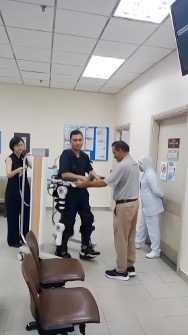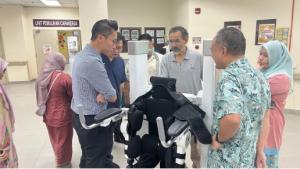UGO Exoskeleton Launches at Hospital Sultanah Bahiyah, Pioneering Next-Gen Rehabilitation in Malaysia

UGO exoskeleton trial at HSB: clinician-led setup, real-time adjustments, and over-ground walking to assess tolerance and cadence.
UGO debuts at Hospital Sultanah Bahiyah as therapists complete hands-on training, praising ease, safety and impact on lower-limb rehabilitation.
Designed specifically for rehabilitation medicine, UGO aims to assist patients in recovering lower-limb function following stroke, spinal cord injury, traumatic brain injury, and other neurological or musculoskeletal conditions. The device features a therapist-led interface, adjustable assistance levels, and built-in safety mechanisms that help clinicians tailor therapy dose and intensity while maintaining patient confidence. By supporting repeatable, task-specific practice with consistent parameters, the system complements conventional therapy and helps increase meaningful repetitions within session time.
“The workshop showed how a new generation of wearable robotics can be integrated sensibly into daily practice,” said the Lead Physiotherapist at Hospital Sultanah Bahiyah’s Rehabilitation Department. “UGO’s ease of set-up and the clarity of its operating logic meant our team could focus on clinical goals rather than device handling. We see strong potential for evidence-based protocols that scale therapy safely and efficiently for diverse patient profiles.”
The programme opened with clinical and engineering briefings covering indications and contraindications, donning and doffing procedures, parameter selection, and risk controls, followed by live demonstrations and structured practice. Hospital therapists trialled UGO in simulated scenarios, including sit-to-stand transitions, over-ground walking, and balance-oriented tasks, under the guidance of experienced product specialists. Participants also reviewed patient screening steps, documentation standards, and workflow considerations to ensure safe, efficient use from ward to outpatient clinic.
“Hospital Sultanah Bahiyah is a high-impact setting to advance rehabilitation,” said Dr Wang Tian, Founder and CEO of RoboCT. “We were impressed by the clinical rigour and patient focus shown by the HSB team. Their feedback will inform our continuing improvements in ergonomics, safety, and usability, and supports our mission to make effective, accessible rehabilitation a reality across Southeast Asia.”
The introduction of UGO at HSB adds fresh momentum to Malaysia’s rehabilitation ecosystem. As demand for post-acute and long-term neurorehabilitation grows, hospitals are seeking practical tools that increase therapy intensity and standardise delivery without adding undue burden to clinical teams. UGO’s therapist-centred design is intended to fit within existing workflows: quick calibration, adjustable gait parameters, and structured progress tracking help therapists set targets, measure response, and iterate plans while keeping patient safety and comfort front of mind.
The workshop also strengthened international collaboration between RoboCT and overseas hospitals, opening channels for joint training, knowledge exchange, and multi-site clinical evaluation. Next steps discussed included establishing a structured training pathway for HSB therapists, developing patient selection criteria and safety checklists, and defining outcome measures to evaluate functional gains, tolerance, and satisfaction. The parties signalled interest in publishing shared learnings to support best practice and to accelerate adoption where appropriate.
UGO’s introduction aligns with a pragmatic vision for technology adoption: start with well-defined use cases, measure what matters, and scale on evidence. By focusing on therapist experience and patient safety, the system aims to reduce friction to adoption and to enable consistent, high-quality therapy dose—both critical to functional recovery. For patients and families, the promise is straightforward: more opportunities to practise meaningful movement in a controlled, motivating environment guided by trained clinicians.
“Technology should serve clinicians and empower patients,” added Leo Wang, the International Partnerships Director at RoboCT. “Our approach is to co-design with therapists, iterate quickly, and ensure that each feature translates into real-world benefit. The response at Hospital Sultanah Bahiyah reinforces that we are on the right track.”
Workshop Highlights
• Workshop in progress: clinicians received structured briefings and practical demonstrations covering safety, set-up, and parameter tuning.
• Hands-on experience (1): hospital therapists practised donning and doffing and explored early-stage mobilisation protocols.
• Hands-on experience (2): participants trialled over-ground gait tasks and balance exercises while monitoring patient response.
• UGO operation demonstration: product specialists showcased real-time adjustments and data capture designed to support clinical decision-making.
About Hospital Sultanah Bahiyah
Hospital Sultanah Bahiyah (HSB) is the largest hospital in northern Malaysia, delivering comprehensive medical and surgical services to a wide catchment population. The hospital’s Rehabilitation Department provides multidisciplinary care across the continuum—from acute stabilisation to community reintegration—supported by dedicated clinicians and modern facilities.
About RoboCT
RoboCT is a medical technology company focused on intelligent rehabilitation solutions that help people regain mobility and independence. Its UGO exoskeleton combines human-centred design with robust safety controls to support therapist-guided gait training across a range of clinical settings. Working with partners worldwide, RoboCT advances training, research, and service models that bring effective rehabilitation within reach for more patients.
Leo Wang
RoboCT
+86 566 375 9821
email us here
UGO Exoskeleton: Restoring Mobility for Lower-Limb Dysfunction
Legal Disclaimer:
EIN Presswire provides this news content "as is" without warranty of any kind. We do not accept any responsibility or liability for the accuracy, content, images, videos, licenses, completeness, legality, or reliability of the information contained in this article. If you have any complaints or copyright issues related to this article, kindly contact the author above.


